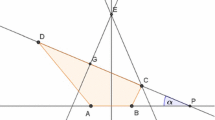Abstract
The prime motivation for the present study is a famous problem, allegedly first formulated in 1643 by Fermat, and the so-called Complementary Problem (CP), proposed but incorrectly solved in 1941 by Courant and Robbins. For a given triangle, Fermat asks for a fourth point such that the sum of its Euclidean distances, each weighted by +1, to the three given points is minimized. CP differs from Fermat in that the weight associated with one of these points is −1 instead of +1. The geometrical approach suggested in 1998 by Krarup for solving CP is here extended to cover any combination of positive and negative weights associated with the vertices of a given triangle. Among the by-products are surprisingly simple correctness proofs of the geometrical constructions of Torricelli (around 1645), Cavalieri (1647), Viviani (1659), Simpson (1750), and Martelli (1998). Furthermore, alternative proofs of Ptolemy's theorem (around A.D. 150) and an observation by Heinen (1834) are provided.
Similar content being viewed by others
References
Cavalieri, B. (1647). Exercitationes geometricae. Bologna.
Cockayne, E.J. and Z.A. Melzak. (1969). “Euclidean Constructability in Graph-Minimization Problems.” Mathematics Magazine 42, 206–208.
Courant, R. and H. Robbins. (1941). What is Mathematics? Oxford: Oxford University Press.
Coxeter, H.M.S. and S.L. Greitzer. (1967). Geometry Revisited. Yale University: The Mathematical Association of America.
Drezner, Z. and G.O. Wesolowsky. (1990). “The Weber Problem on the Plane With Some Negative Weights.” INFOR 29, 87–99. (Our reprint bears “1991“ as the publication year whereas other authors including Drezner and Wesolowsky themselves seem to agree on “1990“ when this article is being referenced in other writings.)
Engelbrecht, E. (1877). “Planimetrischer Lehrsatz.” Arch. Math. Phys. 60, 447–448.
Fagnano, G. (1775). “Problemata Quedum ad Methodum Maximorum et Minimorum Spectantia.” Nova Acta Eruditorum Anni 1775; Lipsiae 1779.
Heinen, F. (1834). Über Systeme von Kräften. Gymnasium zu Cleve (gedruckt bei G.D. Bädeker, Essen), pp. 18–19.
Hofmann, J.E. (1929). “Elementare Lösung einer Minimumsaufgabe.” Zeitschr. Math.-Naturwiss. Unterr. 60, 22–23.
Hofmann, J.E. (1969). “Über die geometrische Behandlung einer Fermatschen Extremwert-Aufgabe durch Italiener des 17. Jahrhunderts.” Sudhoffs Archiv 53, 86–99.
Jalal, G. (1997). “Single-Facility Location Problems with Arbitrary Weights.” M.Sc. Thesis, DIKU.
Krarup, J. (1998). “On a “Complementary Problem” of Courant and Robbins.” Location Science 6, 337–354.
Krarup J. and S. Vajda. (1997). “On Torricelli's Geometrical Solution to a Problem of Fermat.” IMA Journal of Mathematics Applied in Business & Industry 8, 215–224.
Kupitz, Y.S. and H. Martini. (1997). “Geometric Aspects of the Generalized Fermat–Torricelli Problem.” In Intuitive Geometry, Mathematical Studies, Vol. 6, Bolyai Society, pp. 55–127.
Martelli, M. (1998). “Geometrical Solution of Weighted Fermat Problem About Triangles.” In F. Giannessi et al. (eds.), New Trends in Mathematical Programming. Dordrecht: Kluwer Academic Publishers, pp. 171–180.
Pesamosca, G. (1991). “On the Analytic Solution of the 3-PointWeber Problem.” Rendiconti diMatematica, Ser. VII 11, 39–45.
Rademacher, H. and O. Toeplitz. (1990). Enjoyment of Mathematics. New York: Dover.
Simpson, T. (1750). The Doctrine and Application of Fluxions. London.
Sokolowsky, D. (1976). “A Note on the Fermat Problem.” The American Mathematical Monthly 83, 276.
Tellier, L.-N. and B. Polanski. (1989). “The Weber Problem: Frequency of Different Solution Types and Extension to Repulsive Forces and Dynamic Processes.” Journal of Regional Science 29, 387–405.
Torricelli, E. (1919). “De Maximis et Minimis.” In G. Loria and G. Vassura (eds.), Opere di Evangelista Torricelli. Faenza, Italy.
Viviani, V. (1659). De maximis et minimis divinato in quintum conicorum Apollonii Pergaei, Part II. Firenze.
Weber, A. (1909). Über den Standort der Industrien. Tübingen. Also available as C.J. Friedrich (trans.), Theory of the Location of Industries. Chicago: University of Chicago Press, 1929.
Wesolowsky, G.O. (1993). “The Weber Problem: History and perspectives.” Location Science 1, 5–23.
Zacharias, M. (1914). “Maxima und Minima.” In Encyklopädie der Mathematischen Wissenschaften, Bd. III, 1. Teil, 2, section 28 in Elementargeometrie. Leipzig: Hälfte, pp. 1118–1137.
Author information
Authors and Affiliations
Rights and permissions
About this article
Cite this article
Jalal, G., Krarup, J. Geometrical Solution to the Fermat Problem with Arbitrary Weights. Annals of Operations Research 123, 67–104 (2003). https://doi.org/10.1023/A:1026167011686
Issue Date:
DOI: https://doi.org/10.1023/A:1026167011686




